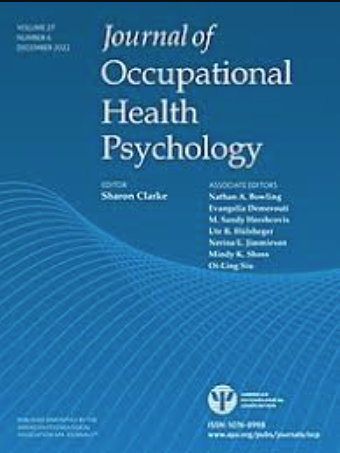Hidden costs of anticipated workload for individuals and partners: Exploring the role of daily fluctuations in workaholism.
IF 5.9
1区 心理学
Q1 PSYCHOLOGY, APPLIED
Journal of Occupational Health Psychology
Pub Date : 2021-10-01
Epub Date: 2021-07-22
DOI:10.1037/ocp0000284
引用次数: 6
Abstract
The present study advances a within-person approach to the study of workaholism in line with whole trait theory, arguing that individuals have general workaholic tendencies as well as daily fluctuations in workaholism. We tested this model using an experience sampling study of 121 U.S. employees and their spouses who completed self-report surveys for 10 working days. Multilevel analyses supported the idea that workaholism varies at the daily level, and trait workaholism was significantly related to higher daily fluctuations in workaholism averaged across the 10 days. Consistent with whole trait theory (Fleeson, 2007), we found anticipated workload each morning positively related to daily fluctuations in workaholism. Moreover, individuals reported feeling more fatigued on days they report higher daily workaholism, and daily fluctuations in workaholism were related to stress crossover and spouse's relationship tension. Overall, results support a within-person conceptualization of workaholism, linking anticipated workload to daily fluctuations in workaholism, which in turn demonstrates negative spillover and crossover outcomes. (PsycInfo Database Record (c) 2021 APA, all rights reserved).个人和合作伙伴预期工作量的隐性成本:探索工作狂日常波动的作用。
本研究基于整体特质理论,提出了一种基于人的工作狂研究方法,认为个体具有普遍的工作狂倾向,并且工作狂的日常波动。我们对121名美国雇员及其配偶进行了为期10个工作日的自我报告调查,并对该模型进行了经验抽样研究。多水平分析支持这样一种观点,即工作狂在日常水平上是不同的,工作狂特质与10天内平均每天的工作狂波动显著相关。与整体特质理论一致(Fleeson, 2007),我们发现每天早上的预期工作量与工作狂的日常波动呈正相关。此外,个人报告说,在他们报告每天工作频率较高的日子里,他们会感到更疲劳,而每天工作频率的波动与压力交叉和配偶关系紧张有关。总体而言,研究结果支持个人对工作狂的概念化,将预期工作量与工作狂的日常波动联系起来,这反过来又证明了负面溢出和交叉结果。(PsycInfo Database Record (c) 2021 APA,版权所有)。
本文章由计算机程序翻译,如有差异,请以英文原文为准。
求助全文
约1分钟内获得全文
求助全文
来源期刊
CiteScore
8.20
自引率
5.90%
发文量
46
期刊介绍:
Journal of Occupational Health Psychology offers research, theory, and public policy articles in occupational health psychology, an interdisciplinary field representing a broad range of backgrounds, interests, and specializations. Occupational health psychology concerns the application of psychology to improving the quality of work life and to protecting and promoting the safety, health, and well-being of workers. This journal focuses on the work environment, the individual, and the work-family interface.

 求助内容:
求助内容: 应助结果提醒方式:
应助结果提醒方式:


